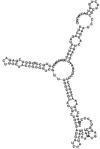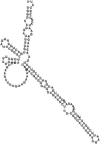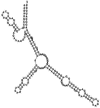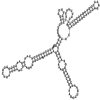Prediction of candidate small non-coding RNAs in Agrobacterium by computational analysis
- PMID: 23554609
- PMCID: PMC3596533
- DOI: 10.1016/S1674-8301(10)60006-1
Prediction of candidate small non-coding RNAs in Agrobacterium by computational analysis
Abstract
Small non-coding RNAs with important regulatory roles are not confined to eukaryotes. Recent work has uncovered a growing number of bacterial small RNAs (sRNAs), some of which have been shown to regulate critical cellular processes. Computational approaches, in combination with molecular experiments, have played an important role in the identification of these sRNAs. At present, there is no information on the presence of small non-coding RNAs and their genes in the Agrobacterium tumefaciens genome. To identify potential sRNAs in this important bacterium, deep sequencing of the short RNA populations isolated from Agrobacterium tumefaciens C58 was carried out. From a data set of more than 10,000 short sequences, 16 candidate sRNAs have been tentatively identified based on computational analysis. All of these candidates can form stem-loop structures by RNA folding predictions and the majority of the secondary structures are rich in GC base pairs. Some are followed by a short stretch of U residues, indicative of a rho-independent transcription terminator, whereas some of the short RNAs are found in the stem region of the hairpin, indicative of eukaryotic-like sRNAs. Experimental strategies will need to be used to verify these candidates. The study of an expanded list of candidate sRNAs in Agrobacterium will allow a more complete understanding of the range of roles played by regulatory RNAs in prokaryotes.
Keywords: Agrobacterium tumefaciens genome; small RNAs; small non-coding RNAs; solexa sequencing technology.
Figures

















Similar articles
-
Identification and functional characterization of small non-coding RNAs in Xanthomonas oryzae pathovar oryzae.BMC Genomics. 2011 Jan 30;12:87. doi: 10.1186/1471-2164-12-87. BMC Genomics. 2011. PMID: 21276262 Free PMC article.
-
Computational approaches for the discovery of bacterial small RNAs.Methods. 2007 Oct;43(2):131-9. doi: 10.1016/j.ymeth.2007.04.001. Methods. 2007. PMID: 17889800
-
Genome-wide identification and characterization of small RNAs in Rhodobacter capsulatus and identification of small RNAs affected by loss of the response regulator CtrA.RNA Biol. 2017 Jul 3;14(7):914-925. doi: 10.1080/15476286.2017.1306175. Epub 2017 Mar 15. RNA Biol. 2017. PMID: 28296577 Free PMC article.
-
Small Noncoding RNAs in Agrobacterium tumefaciens.Curr Top Microbiol Immunol. 2018;418:195-213. doi: 10.1007/82_2018_84. Curr Top Microbiol Immunol. 2018. PMID: 29556823 Review.
-
How to find small non-coding RNAs in bacteria.Biol Chem. 2005 Dec;386(12):1219-38. doi: 10.1515/BC.2005.140. Biol Chem. 2005. PMID: 16336117 Review.
Cited by
-
In silico prediction and expression profile analysis of small non-coding RNAs in Herbaspirillum seropedicae SmR1.BMC Genomics. 2020 Feb 10;21(1):134. doi: 10.1186/s12864-019-6402-x. BMC Genomics. 2020. PMID: 32039705 Free PMC article.
-
Milk-borne infections. An analysis of their potential effect on the milk industry.Germs. 2012 Sep 1;2(3):101-9. doi: 10.11599/germs.2012.1020. eCollection 2012 Sep 1. Germs. 2012. PMID: 24432270 Free PMC article. Review.
-
Computational prediction of microRNAs in marine bacteria of the genus Thalassospira.PLoS One. 2019 Mar 12;14(3):e0212996. doi: 10.1371/journal.pone.0212996. eCollection 2019. PLoS One. 2019. PMID: 30861013 Free PMC article.
References
-
- Gottesman S. Micros for microbes:non-coding regulatory RNAs in bacteria. Trends Genet. 2005;21:399–404. - PubMed
-
- Livny J, Waldor MK. Identification of small RNAs in diverse bacterial species. Curr Opin Microbiol. 2007;10:96–101. - PubMed
-
- Kulkarni RV, Kulkarni PR. Computational approaches for the discovery of bacterial small RNAs. Methods. 2007;43:131–9. - PubMed
-
- Rivas E, Klein RJ, Jones TA, Eddy SR. Computational identification of non-coding RNAs in E. coli by comparative genomics. Curr Biol. 2001;11:1369–73. - PubMed
LinkOut - more resources
Full Text Sources
Miscellaneous

